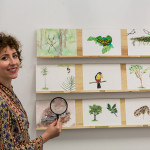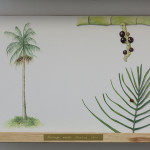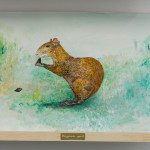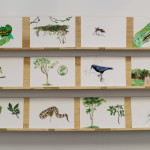Lilian Maus | Inventário de Fauna e Flora
Título: Inventário de Fauna e Flora / Fauna and Flora Inventory
RESUMO: Com aproximadamente 44 mil habitantes (IBGE/2016), Osório é um corredor ecológico onde o vento sopra com vigor sobre um relevo dividido. De um lado está a Planície Costeira – formada pelos campos banhados por 23 lagoas e pelo mar, na qual reside a maior parte dos moradores e onde também está localizado o centro histórico, com sua catedral, hospital e a maior parte dos serviços – e de outro, a Serra Geral – revestida pela Mata Atlântica, preservada nas Áreas de Proteção Ambiental (APAs), além das áreas rurais, onde reside a comunidade do Morro da Borússia e se encontram as vertentes que deságuam nas lagoas da planície. Desde 2006, a cidade recebeu o slogan “Terra dos Bons Ventos”, em razão da implantação de um dos maiores complexos de Parques Eólicos da América Latina.3 Os mais de 425 gigawatts de energia anuais produzidos pelo contato do ar com as pás dos rotores – acoplados às torres de concreto dos cata-ventos de 98 metros – vêm repelindo das conversas dos moradores as queixas sobre o vento. Trata-se de um importante projeto de geração de energia para o estado e que vem trazendo benefícios à cidade. Apesar da energia dos cata-ventos ser considerada limpa por não emitir CO2 na atmosfera, há uma série de impactos ambientais implicados na sua distribuição. A construção das torres de transmissão requer o desmatamento das áreas em que são implantadas e, depois de instaladas, geram ondas eletromagnéticas que afetam o desenvolvimento da fauna e da flora ao seu redor. Atualmente, está em curso um empreendimento da Eletrosul que projeta o traçado das linhas de energia LT 230 KV Gravataí 3-Osório 3 sobre os terrenos mais sensíveis das APAs da Mata Atlântica do Morro da Borússia, protegida por lei. A comunidade, organizada através da AMASB (Associação de Moradores e Amigos da Serra da Borússia), entrou com ação no Ministério Público contra o atual traçado e reivindica um novo trajeto para as torres, solicitando sua relocação para terras de menor impacto ambiental, evitando assim os danos irreversíveis ao bioma da mata já tão devastada. O movimento em defesa da terra e do patrimônio natural da humanidade tem ampliado o diálogo entre a comunidade que vive em cima do morro e aquela que vive abaixo. Em muitas situações eu mesma intermediei essa conversa, pois transito entre as duas zonas. No centro da cidade está meu ateliê/casa e, no morro, tenho um sítio de 13 hectares que se estende do pé ao topo da montanha, no quilômetro 85,7 da Rodovia Federal BR-101. Desde junho de 2016, venho participando ativamente das ações e discussões comunitárias sobre o empreendimento da Eletrosul. A comunidade não se posiciona contrária à implantação das torres, mas, sim, ao trajeto projetado, que poderia ter outro desenho, passando por áreas que não fossem reservas florestais nem estivessem tão próximas das zonas de apicultura, visto que a frequência eletromagnética das torres interfere no processo de polinização das abelhas. Cerca de 100 famílias serão atingidas se o projeto for levado à frente da forma como foi concebido. Ao longo dos quatro anos de expedição pela Paragem das Conchas, o vento foi ganhando certo peso e solidez diante do meu olhar e dos outros moradores. Se antes as causas e as consequências da existência dele – que seguirá soprando independente da implantação de cata-ventos ou do julgamento humano – pareciam não interferir na quietude na montanha, hoje, com a promessa do uso da energia eólica, a história vem mudando e a montanha se vê ameaçada. Tanto o vento como o morro, manifestações naturais que nasceram muito antes de nós, vão sendo redefinidos pela ação humana que manipula esse horizonte. Gestos que plantam e derrubam árvores; agarram e soltam pedras; brincam e matam; remam e conduzem o volante ou o cavalo; pintam, escrevem e apagam o papel; constroem torres e cata-ventos ou assinam petições públicas em defesa da mata.
ABSTRACT: With approximately forty-four thousand inhabitants (IBGE/2016), Osório is an ecological corridor where the wind blows strong across a divided landscape. On one side there are the coastal plains – fields consisting of 23 ponds, lakes, and the sea. This is the most densely populated area and includes the historical center with its cathedral, hospital and most businesses. On the other side we have the mountain range – covered by the Atlantic Forest it consists of preserved areas as well as farmlands, where the community of Morro da Borússia lives and where the water that flows into the ponds comes from. In 2006 the city was given the moto “Land of good winds” due to the establishing of the largest wind farm in Latin America3. As the wind touches the blades on the rotors sitting atop the 98-meter tall concrete vane, 425 gigawatts of power are generated every year – removing the complaints regarding the wind from the local’s small talk repertoire. It is an important project that generates power to the state and brings many benefits to the city. Although the energy generated by the wind turbines is considered clean, as it does not add any CO2 to the atmosphere, there is an environmental impact connected to its installment. Building the wind turbines requires the area to be deforested, and once installed they generate electromagnetic waves that interfere with the development of the fauna and flora surrounding them. A project by company Eletrosul that is currently underway places the power lines LT 230 KV Gravataí 3-Osório 3 on some of the most sensitive protected areas of the Atlantic Forest in Morro da Borússia, which should, by law, be protected. The community has organized itself through an association of residents and supporters to file a complaint with Brazil’s public prosecutor’s office against the current project and demanding a new pathway going through lower impact areas for the towers in order to avoid irreparable damage to the already devastated biome of the forest. This movement in defense of the Earth and this natural heritage site has broadened the dialogue between the community that lives on the mountains and the community that resides at the foot of the mountains. On many occasions I mediated that dialogue myself, as I moved between both zones. In the center of the city I have my studio/home and up the mountain I own a 32 acre property stretching from the bottom to the top of the mountain, located at KM 85,7 on the BR-101 highway. Since June 2016 I have been actively involved in the community’s actions and discussions regarding Eletrosul’s project. The community is not opposed to the installment of the turbines, but simply disapproves of the location where they are being installed. Instead they could go through areas that are not protected forest or as close to the beekeeping zones, since the electromagnetic frequencies emanating from the turbines interferes with pollination. Around a hundred families will be affected if the project goes on as currently planned. Throughout these four years exploring Paragem das Conchas, the wind began to take shape as a solid subject, both in my eyes and those of other residents. Whereas before the causes and consequences of its existence – and it will continue to exist, blowing regardless of the wind farm and human will – seemed not to interfere in the quietness of the mountain, today the promise of eolic energy is changing things and the mountain finds itself at risk. Both the wind and the mountain, natural wonders born long before us, are being redefined by human action manipulating this horizon. Gestures planting and cutting down trees; holding and letting go of rocks; playing and killing; rowing and steering the wheel or the horse; painting, writing and erasing the paper; building towers and vanes or signing petitions to protect the woods.
FICHA TÉCNICA
Ano/Year: 2016
Autor/Author: Lilian Maus
E-mail: lilimaus@gmail.com
MAUS, Lilian. Inventário de fauna e flora. ClimaCom – Diálogos do Antropoceno [online], Campinas, ano. 5, n. 12. Ago. 2018 . Available from: https://climacom.mudancasclimaticas.net.br/?p=9735
BAIXAR PRODUÇÃO ARTÍSTICA EM PDF
SEÇÃO ARTE |DIÁLOGOS DO ANTROPOCENO |Ano 5, n. 12, 2018
ARQUIVO ARTE |TODAS EDIÇÕES ANTERIORES








